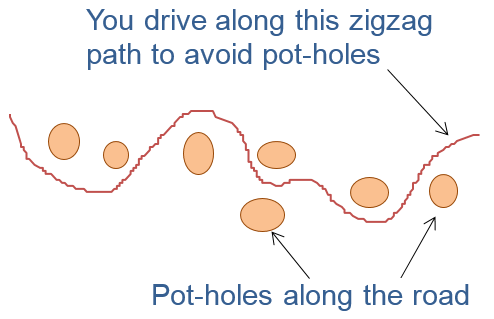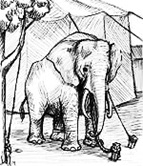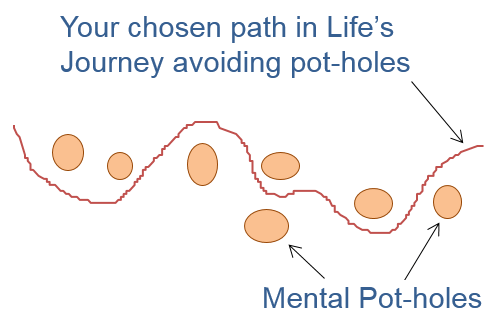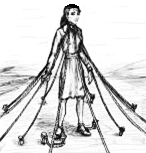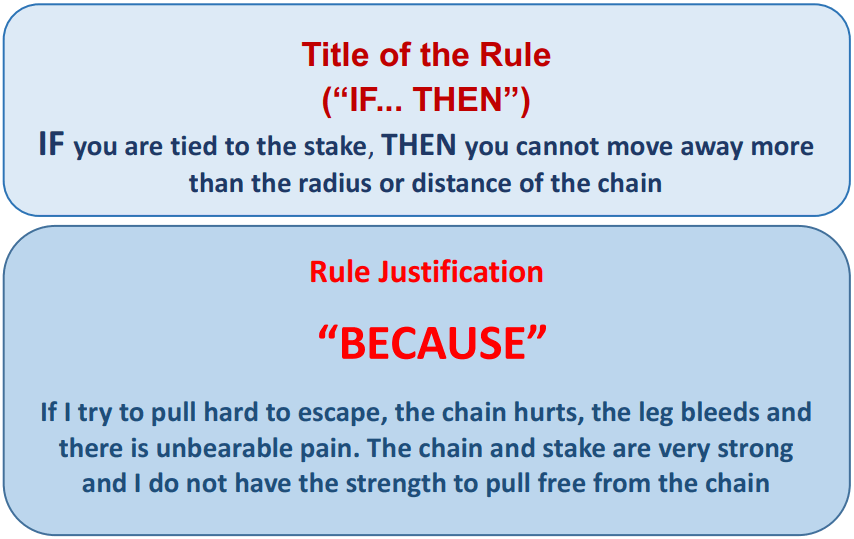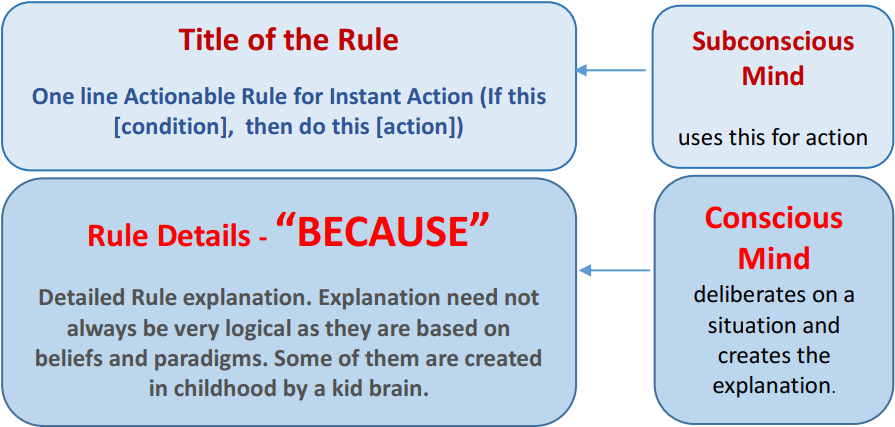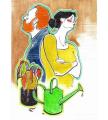| Copyright © 2001-25 Prem Kamble | ||||||||||||||||||||||||||||||||||||||||
| What is Subconscious Mind? How Does it Control Our Actions? | ||||||||||||||||||||||||||||||||||||||||
| Read in Hindi || Related Articles || Available in 8 Journals | ||||||||||||||||||||||||||||||||||||||||
|
AbstractIn this thought-provoking paper, Prem Kamble challenges the notion that we are in control of our actions and behavior. Through compelling evidence, the author illustrates that we have very little control over our actions, as they are mostly driven by our subconscious mind. The author introduces a new concept of "Mental Reflex Actions™" - actions triggered by our subconscious mind that are beyond our conscious control. The paper explores both controllable and uncontrollable human behavior. It explains the meaning of subconscious mind, and the unfathomable nature of what gets stored in the subconscious mind. It introduces a new idea of "Subconscious Rule Book" and explains how its contents dictate the course of our lives. Our conscious mind is often unaware of this rule book. Most of us live our entire life without knowing what is stored in our subconscious rule book. Unearthing the contents of our Subconscious Rule Book can transform our lives. It can increase self-awareness and help us understand our reactions and behaviors better by identifying hidden barriers - barriers rooted in the rules that we ourselves wrote in our rule book. By exploring the depths of our subconscious mind, we can gain a deeper understanding of ourselves and those around us. This insight can enhance our interpersonal relationships, both in our personal and professional lives, and improve our people management skills. The paper provides methods not only to uncover the subconscious rule book and unravel its contents, but also to rewrite the irrational rules. The paper concludes by envisioning future potential scientific advancements that could enable the retrieval of the hidden rule book and the rewriting of irrational rules - or even preventing illogical rules formed during childhood from entering the rule book. This paper is a must-read for those seeking to understand the intricacies of the human mind and improve their interpersonal relationships. We Have no Control on Our ActionsHave you ever caught yourself acting in a way you don't like - and then regretted that you did it? Do you often struggle to break free from behaviors that don't serve you, even when you knowingly want to change? Maybe you have tried to change, but despite your best intentions, something deep within you resists leaving you puzzled and frustrated. You dislike a certain behavior or reaction, yet no matter how hard you try, it seems to control you. This internal conflict reveals the complex interplay between our conscious desires and the unconscious forces that shape our actions. What if the answer lies not in your conscious choices, but in a hidden part of your mind? The real reason isn't laziness or lack of willpower - it is the unseen forces of your Subconscious Mind silently steering your actions, often without your conscious permission. Understanding the role of the subconscious mind can help us uncover the hidden patterns driving our behaviors and unlock the potential for real change Contrary to popular belief, we have limited control over our actions. Despite the common assertion, "I am in control of myself", the reality is that we are often compelled to behave in ways beyond our conscious awareness. Unbelievable, but true. When we think before we make decisions or act, we do so with our conscious mind. However, life is filled with decisions and actions at every step. Every moment, the mind is busy analyzing, making split-second decisions and taking actions. Not all of these actions result from conscious analysis; most are the product of unconscious processes. Our subconscious mind influences our behavior in countless ways, often without us realizing it. Most of our undesirable behavior arises from the subconscious mind and hence we find it difficult to change. Yet, most of us live our entire life without knowing what is hidden in our subconscious mind. By exploring the workings of the subconscious mind and its impact on our behavior, we can gain a deeper understanding of ourselves and find inner peace. Understanding the role of the subconscious mind can also help us comprehend others better and improve our relationships. What is Subconscious Mind?Write to Me | Comments | Related Articles | Top One common example used to explain the subconscious mind is the process of learning to drive a car. When you first start learning, your full attention is focused on the details of the task: the gears, the clutch, and the road ahead. You observe every pothole, bump, and obstacle with acute awareness, as you consciously navigate the vehicle (Fig. 1). However, as you become more proficient, the task is delegated to your subconscious mind, and you start driving without any conscious effort. The process transitions from conscious effort to unconscious habit. You begin to drive without deliberate thought, instinctively avoiding obstacles and shifting gears as needed, all while engaging in other activities such as conversation, listening to music, and enjoying the scenery.
Through repeated practice, the act of driving becomes ingrained in the subconscious mind, freeing the conscious mind from the task. Driving decisions and actions transition from the conscious mind to the subconscious mind, allowing you to make decisions automatically and drive instinctively. By the time you reach your destination, you may not recall specific bumps or potholes encountered along the way, as your subconscious mind smoothly navigated the journey without conscious awareness. You performed all these actions without being consciously aware of them.
The example of an elephant in a circus provides another excellent illustration of the workings of the subconscious mind. If you have ever been to a circus, you may have observed that the enormous elephants are secured by a chain tied to a small stick driven into the ground (called a stake). With its incredible strength, the mighty elephant can easily pull the stake from the ground and escape. However, it chooses not to. Once tethered to the stake, the elephant stays put. This raises the question: what compels the elephant to remain tied?
Years ago, when the elephant was young, it was tied up with the same chain to the same stake. The baby elephant made several attempts to escape, but to no avail. It pulled with all its might, causing its feet to bleed and experiencing great pain. It tried again and again, and eventually gave up. The repeated failed attempts to break free, fueled with the sight of blood and fear of pain, only reinforced the belief that it was impossible to escape when tied to the stake. Over time, this belief became ingrained in the elephant's subconscious mind. Years later, despite having grown up and having acquired enough strength to uproot the stake, the elephant still chooses to remain within the radius of the chain. The subconscious mind controls the elephant's actions and behaviors for the rest of its life, much like it controls the actions of a car driver. Repeated events, occurrences, experiences, or self-assertions can embed an idea, learning, or rule into the subconscious mind, causing one to follow that rule automatically, like a robot, without conscious decision-making. To better understand the workings of the subconscious mind, try the following exercise: Hold your arm horizontally in front of your face with the palm flat and facing up. Now, close your eyes and imagine that you are holding a lemon on your palm right before your eyes. I encourage you to try this exercise before reading any further. Did you experience your mouth watering when you imagined a lemon in your palm? The conscious mind knows that there is no lemon and that it is only an imagination. However, the subconscious mind is irrational and blindly reacts to the imagery presented by the conscious mind, leading to a physical response such as salivation. While the conscious mind is responsible for logical and analytical reasoning, the subconscious mind is characterized by its irrationality and intuitive nature. Consequently, the subconscious mind is often illogical and can lead to behaviors and actions that seem irrational from a logical standpoint. We will see that this irrationality arises out of blindly, instantaneously and intuitively following certain rules written in its rule-book. I call it the Subconscious Rule Book™ Write to Me | Comments | Related Articles | Top Subconscious Rule Book™

Just as we avoid potholes and negotiate bumps while driving a car, we have been navigating life's journey since early childhood, encountering various obstacles and challenges along the way. These experiences have taught us important lessons, giving us insights to identify the potholes and bumps on the road of life. Based on whether the outcomes of our earlier reactions were positive or negative, we made important judgments and decisions about what to do and what to avoid, or about our life's do's and don'ts. We made our inferences on where the life's potholes and bumps lie, what they look like, and how we should either avoid or manage them throughout life. We formed opinions and passed judgments about ourselves, about people around us, deciding what types of people are good or bad. We accumulated lessons and created our very personal book of behavioral ground rules, or what I call "The Subconscious Rule Book™". This rule-book is the foundation of our beliefs and biases which we carry throughout our lives. We call it the subconscious rule book because, as we will see later, most of these rules eventually reside in the subconscious mind, hidden from conscious awareness. This book, in addition to having rules, also records our own opinions and biases about ourselves and others. All of us have made conclusions about people based on their appearance. For example, if we had a bad experience with someone who had a long nose and grey eyes, and this experience was repeated by chance, our brain might conclude that all people with long noses and grey eyes are bad. An irrational rule was then written into our subconscious rule book. Remember, we started writing into this rule book when we were kids. Whenever we encountered situations or conditions that resulted in unpleasant experiences, our brain devised ways to avoid them by retracting, withdrawing, eluding, evading or staying clear of such situations. For instance, if you went to a party and had an embarrassing experience, or someone made an unpleasant comment about you, you might judge yourself harshly and add a rule in your rule book: never go to parties again. A few repetitions of similar incidents, and this rule became ingrained in your subconscious rule book. For the rest of your life, you would subconsciously avoid parties, without your conscious mind being aware of the rule you wrote that has been driving your decisions. We have identified the potholes along the path of our lives. These potholes are situations or conditions that have caused embarrassment or unpleasant experiences in the past. These can also be specific physical traits we have associated with "bad guys to avoid". I will call them "mental potholes" because they may not be real; they are creations of our minds. As we navigate through life's journey, we consciously strive to steer clear of these mental potholes (Fig. 2). Unfortunately, our brain tries to seek further validation to support our beliefs and rules, even if they may not necessarily be logical. When some of these experiences are repeated, even by chance, our beliefs receive the validation that we subconsciously try to seek: "See, I was right!" we tell ourselves. We obviously feel happy when we are proved right. Just as our driving skills become automatic through frequent repetition, our brain's judgments and rules also become deeply ingrained in our subconscious mind through repeated reinforcement. Once embedded in the subconscious mind, these beliefs and rules remain active throughout our lives, even if our conscious mind has relegated them and forgotten about them. In a later section, we will see why these rules fade from our conscious memory.
These rules get so firmly established in our subconscious mind that we automatically react to people and situations according to the guidelines in our rule book. We may not even be aware of why we reacted in a certain way, or that our reaction was exactly as dictated by the subconscious rule book. Similar to how we drive the car, avoiding potholes and slowing down for bumps without consciously noticing, we tread the life's path avoiding imaginary mental potholes, slowing down for the bumps that we have defined, without even realizing that we are doing so, and without realizing why we are doing so (Fig. 2). Despite our self-perception of being highly balanced and making conscious decisions, our behavior is largely involuntary and governed by the knowledge base and rule-book stored in our subconscious mind. We often react without consciously knowing why. I call such actions Mental Reflex Actions™ (discussed later). As we navigate through life's journey, we often drive topsy-turvy due to the mental potholes that we have defined since childhood (Fig. 2). Similar to the elephant's situation, these mental potholes may no longer exist due to changed conditions or may have never existed in the first place It is possible that we have erred in our judgment and created bumps where there are none. Despite this, we continue to avoid these mental potholes or slow down for bumps without consciously noticing these imaginary potholes, or our erratic driving. You may have experienced sometimes that you act in a certain way and then immediately ask yourself, "Hey, why did I do that?" Most likely, you did so because of a mental pothole. You will be surprised to know that actually the situations may have changed, conditions in your life may have evolved, your own abilities have improved, but you were simply reacting to a mental pothole in the way your mind has been conditioned to react to it. By the time we become adults, we accumulate a vast list of rules, essentially authoring a personal volume of rule book. Similar to the elephant's situation, most of our rules are restrictive and tie us down, acting as barriers that prevent us from taking action. Since we feel a sense of satisfaction when we are proved right, we subconsciously seek out situations or create conditions that validate our rules. We almost fall in love with our rule book. We continue to add new rules throughout our lives, resulting in a massive collection of guidelines in our Subconscious Rule Book™. Anatomy of a Subconscious RuleWrite to Me | Comments | Related Articles | Top
To gain a better understanding of our subconscious rules, we can refer back to the example of the elephant tied to a stake. The baby elephant struggled and pulled until its feet bled and it was in pain. Despite repeated attempts to break free, the elephant eventually gave up. It then wrote a rule on stone: "When you are tied to a stake, stay put." This rule was reinforced through repeated attempts to break free and eventually became a part of the subconscious rule book. Upon closer inspection, it becomes evident that every rule is composed of two distinct components:
By grasping these two components of a rule, we can gain a deeper understanding of our subconscious rule book and the beliefs and biases that guide our behaviour. We can understand how our rule book governs our actions and lives with an analogy of the policy documents used by businesses. In business organizations, there is a hierarchy where senior managers define policies, procedures and rules by brainstorming on the rationale and justifications. But when they create the rule book or the policy document, they only include the "Rule Titles", but never the "Rule Justifications" (Fig. 3). The junior employees are oblivious of the justifications, they only see the "Rule Titles" which they follow without questioning. This structure accelerates decision-making, as junior officers can take appropriate and quick action based on established rules and guidelines. It enhances efficiency and seems to be the optimal way to operate. Senior managers are not disturbed by the employees for minor day-to-day operations, allowing them to concentrate on more significant, strategic decisions for the future, while the junior employees can act following established rules and procedures. We can also compare our rule book to a computer program. A human (programmer) designs the logic and codes it into a program, which consists of a set of instructions specifying "what to do when". The computer program includes instructions of the type "IF...THEN.." discussed earlier. The program is then executed by the computer's Central Processing Unit (CPU), which follows the instructions without questioning, regardless of their accuracy, much like a mindless follower. In humans, as per our analogy of businesses and the computer, the conscious mind is equivalent to senior officers in a business organization or a computer programmer. The conscious mind, which is logical and analytical, writes the "Rule Justification" part of our rule. Once the rules are established, the conscious mind delegates the rule book (containing only the 'Rule Titles') to the subconscious mind. Since the conscious mind is constantly busy and our brains must make quick decisions every moment, the subconscious mind acts like junior officers or the computer CPU, swiftly executing actions based on the rule book (see Fig. 4).
So, what does the subconscious mind do? The subconscious mind only looks at the title of the rule (IF...THEN..) and instantly acts accordingly, without considering the second part of the rule, that is, detailed 'Rule Justification' or "Because" logic. The subconscious mind possibly does not even have access to the Rule Justification or detailed explanation part of the rule. Similarly, in businesses, policy documents only contain rules, without providing the reasoning behind them. Junior officers follow the rules without being given details about the reasoning behind them. The subconscious mind simply executes the rules, doing a super quick and efficient job, while the conscious mind remains undisturbed. This process improves the decision-making ability of the conscious mind and allows for quicker execution of actions by the subconscious mind, similar to how businesses operate. However, there is a significant problem that arises. The Problem with the Subconscious Rule Book™Write to Me | Comments | Related Articles | Top The overall strategy appears sound and logical - both for individuals and businesses. It makes sense to spend time analyzing situations, formalizing procedures, and documenting rules in a rulebook to enable quick, on-the-spot decision-making. While this approach works well for organizations, it presents a major challenge for individuals. In contrast to businesses, where rules and procedures are crafted by competent and experienced minds, our personal "rulebooks" governing our behavior are often created by immature, underdeveloped and inexperienced minds, and are not reliable. The issue lies in the fact that we began forming these judgments at a very young age when we lacked both the ability to properly assess the situations, and the maturity to make well-informed decisions. Consequently, guided by our juvenile perspectives in our early childhood, we established a set of do's and don'ts based on our limited understanding of the world. It is said that by the age of 9, our rule book is already complete. And guess what, the Subconscious Rule book that drives our lives is a bundle of irrational rules authored by an ignorant child's mind. Since most of the rules are written in our childhood, they are often illogical. Before we can mature and re-evaluate them with a more mature and conscious brain, these rules created by our kid brain get embedded in our subconscious mind by repeated reinforcements, while they disappear from our conscious mind. The conscious mind is not even aware of these rules, yet our subconscious brain uses them to dictate our actions. While sometimes (but rarely), the title of the rule may surface in our conscious mind revealing the rule that drives a particular action, the second part of the rule or the Rule Justification is rarely noticed by the conscious mind. Most often, the entire rule book remains outside the awareness of the conscious mind. However, our subconscious mind continues to run our lives based on an illogical set of rules! The big question then is, how do we make our conscious mind aware of our rule book? Unfortunately, there are no easy methods. Most of us go through life without ever being aware of the existence of our rule book, let alone its contents. However, we will examine one method to break free from the Subconscious Rule Book in a forthcoming section. Mental Reflex Action™A significant portion of our irrationality can be attributed to our subconscious mind. This irrationality is caused by what I refer to as Mental Reflex Action™, which is similar to the physical reflex action we are familiar with. Physical reflex action occurs when our body reacts to a stimulus before the message reaches our rational brain, resulting in an automatic reaction that we are not consciously aware of. Mental reflex action occurs when our brain makes a split-second decision based on our subconscious rule book, resulting in an automatic response. The brain quickly references the rule book, and executes the resultant action without any delay of conscious reasoning, like a computerized output. As we make numerous split-second decisions every moment, the subconscious rule book helps us make instant decisions each time there is a stimulus. There is, however, a significant difference between physical reflex action and mental reflex action. While we become aware of the reaction a few moments after a physical reflex action, we may never be aware of the reactions resulting from mental reflex action. The elephant does not know that it is reacting to an irrational rule in its rule book. Therefore, the irrational rule book may never get revised or corrected. Why Subconscious Rule Book is HiddenOver time, the subconscious rule book becomes invisible to our conscious mind, hidden beneath the surface like something swept under the rug. These deep-seated rules continue to drive our behavior, but we lose track of how or why they were formed.To better understand this, let's return to our computer analogy. Think of the subconscious mind as the computer's ROM (Read-Only Memory), storing rules permanently, while the conscious mind operates like RAM (Random Access Memory), a dynamic storage handling immediate, active processing. When the conscious mind first formulates a rule (for example, from a significant experience or repeated advice), it saves both the rule and its justification in the conscious memory (RAM). It transfers only the "rule title" to the subconscious (ROM) (Fig. 4). The subconscious mind retains it for life. As life goes on, whenever a situation arises that triggers this rule, the subconscious mind acts on the rule in a flash without the conscious mind being aware of it. This is what we referred to earlier as Mental Reflex Action. With repeated use, the subconscious mind continues to mechanically apply the rule, without the original justification, bypassing the conscious mind. Consequently, as the conscious mind rarely revisits the rule and its justification, that information fades away. That section of the RAM may be reused with new experiences and thoughts. The rule gets completely erased from the conscious memory. The conscious mind, having lost access to the details, eventually forgets why the rule was created in the first place. As these behavioral patterns repeat over time, the subconscious mind keeps reacting based on the rule - now stripped of its justification - continuing to influence actions silently and powerfully, whereas the conscious mind remains oblivious. Games Played by the Subconscious MindWe may not be aware, but our mind plays games with us. Our subconscious mind often operates beneath the surface, driving our actions in ways we may not even realize. Consider the story of a boy who, harboring a grudge against his father, failed an exam. Outwardly, he appeared sad and disappointed, expressing regret over his performance. He even insisted that he had worked hard and wanted to succeed. Yet, deep within his subconscious, there was a hidden satisfaction - he had managed to hurt his father, who had high expectations for his academic success. This inner sense of revenge brought him a quiet happiness, even as he wore the mask of sadness. This story highlights several crucial truths about our minds:
The Subconscious Pain PointsWrite to Me | Comments | Related Articles | Top 
Each of us carries in our minds a list of personal qualities that we consider "not OK". These qualities can pertain to our physical appearance, complexion, abilities, or inherent nature. Such a list of our deemed defficiencies originates from opinions we formed about ourselves during childhood or from past embarrassing experiences that reinforced negative self- assessments. These traits can be divided into two distinct categories:
These "Not OK" traits originate from opinions we formed about ourselves during childhood or from past embarrassing experiences that reinforced negative self- assessments. The first category, the painful traits, consists of qualities that cause distress and a profound sense of inadequacy, leaving us hurt and ashamed when they are brought to our attention. In contrast, the second category includes traits we can comfortably acknowledge without experiencing significant emotional distress. Various incidents in our later lives or different comments we hear can aggravate these pain points. When ruffled, they generate an unpleasant sensation in specific parts of the body. Such events create these body sensations, and our reactions are to these sensations themselves, not to the external events. We find these sensations so uncomfortable or unsettling that we want to dismiss them out of our conscious mind, and slowly we push them under the carpet burying them deep within our subconscious and out of our conscious mind. We attempt to forget these thoughts and memories of our painful traits. Therefore, our subconscious pain points or hidden emotional triggers are typically concealed in deep recesses of our minds, hidden under a self-imposed cover. Although they may fade from our conscious awareness, they continue to exist in our subconscious mind. It is the painful traits and the resulting unpleasant sensations that often compel or push us to exhibit unnatural or abnormal behavior. When you have a stomach ache, the doctor checks for pain by poking various points and asking if it hurts. There may be no pain when the doctor presses at different points, but suddenly, on pressing a particular spot, you scream in pain. The doctor thus locates your physical pain point. Similarly, each of us has psychological pain points related to areas our personality or character that make us feel inadequate, flawed or inferior, or instill thoughts like "I am not OK". Different incidents in life or comments from people around us may lightly touch various parts of our personality, causing little or no pain. However, some incidents poke our subconscious pain points, resulting in an almost explosive reaction. Our behavior is the most unpredictable when we are ruffled by some of our subconscious pain points. Since these pain points differ among individuals, people may react differently to the same stimuli. For instance, one person may be deeply hurt by a derogatory comment, say about physical appearance, while someone else may not care at all. It is not uncommon that when a group of people receives the same derogatory comment, some in the group are driven to extremes, while others remain unfazed. For those who felt hurt, the abuse poked the pain point, whereas for others it did not. We all have pain points, which lead to our idiosyncrasies. When we encounter these subconscious pain points, we are often overwhelmed by intense emotions and we react sharply, revealing the driven nature of our behavior. In these situations, we feel powerless to control our reactions and we react spontaneously and compulsively. Despite our desire to behave differently, our actions are then orchestrated by our subconscious mind. These emotions can be linked to the same sensations that we first experienced when we had that same unpleasant and painful experience as a child, which we tried to banish from our minds. When we get upset, we may tend to blame others or external factors, but this is far from the truth. Very often, we are the ones who have upset ourselves. Whenever we feel annoyed or piqued, it is not because of any external factor, but because of our own inferiority complex, rooted in deep-seated pain points within us. By recognizing this aspect, we unlock deeper insights into human behavior. This awareness can not only spare us a lot of heartburn we experience regarding our own behavior but also foster empathy toward others. When we recognize that others may also have their own unique pain points different from ours, and that they are as helpless when ruffled as we are, we are less likely to be annoyed by their seemingly irrational or spontaneous behavior. Breaking Free from the Subconscious RulesWrite to Me | Comments | Related Articles | Top
The key to uncovering your subconscious mind and breaking free from the shackles of compulsive behavior related to our subconscious rulebook is to unearth these deeply buried memories and unpleasant sensations associated with the pain points and bring them into the conscious awareness - sensations which we ourselves pushed under the carpet and hid from our conscious mind. It is important to recognize that the triggers for our automatic reaction are not events or circumstances, but the sensations. The challenge lies in excavating these deeply buried and suppressed memories nestled deep within our subconscious mind. It is only by acknowledging, uncovering and confronting these painful memories that we can embark on the journey toward healing. The question that follows is: How do we access the depths of our subconscious to uncover these concealed emotional triggers? Moreover, how do we break the link between the trigger and the reaction? There indeed is a method to aid in the discovery and elimination of these hidden unpleasant recordings and emotional triggers from our subconscious mind that impact our actions. Once you recognize the sensation responsible for the action, you can break the link between the trigger and the compulsive action. Here is a simple exercise which provides such a method.The ExerciseThe exercise involves revisiting situations that made you feel angry, embarrassed, or uneasy. Wait untill you regain your normal state of mind, find a quiet place, sit back and relax. Close your eyes and mentally recreate the same situation, the sequence of events and experience that triggered those negative emotions. Imagine that situation in great detail, almost reliving the same moments.As you re-live those moments of your unpleasant experience, notice the thoughts in your mind. Pay attention to the details and notice the sensations in your body, such as in your stomach or any other part of the body, as you relive the unpleasant experience of the day. Keep asking yourself repeatedly, "What are the thoughts in my mind NOW? What are the sensations in different parts of the body RIGHT NOW?" Simply observe and acknowledge your thoughts, feelings and sensations without reacting to them. The key is to bring these unpleasant sensations which we have pushed out deep into the subconscious mind to the surface – notice them and experience them with your subconscious mind. You may encounter uncomfortable or distressing memories and emotions and feel tempted to dismiss or ignore them. You will almost try to shoo them away, as you have been doing all your life, but it is vital to resist this urge and instead keenly observe and experience these sensations and feelings without reacting This exercise is likely to reveal some hidden realities about yourself, uncovering parts of your subconscious mind. You may discover illogical thoughts that triggered the sensation which ultimately resulted in your anger or outburst, leading to the unpleasant experience. The exercise outlined here is a powerful tool for self-discovery and personal growth. By practicing it regularly, you can identify and eliminate pain points in your subconscious mind that may be influencing your behavior. Over time, you may feel lighter and more at ease as you learn to let go of these negative emotions. To maximize the benefits of this exercise, it is essential to follow a critical guideline. As you begin to observe your thoughts, you might uncover memories and experiences that are highly unpleasant and discomforting. The process can also bring forth thoughts and memories that induce feelings of embarrassment, shame, or emotional distress. Engaging in this exercise may touch upon your subconscious pain points, potentially triggering painful and shameful emotions that have long been buried in your subconscious. It is extremely important to simply observe these thoughts and fully experience the associated feelings and sensations without reacting to them. This exercise involves recreating a situation shortly after it occurred. After practicing this exercise repeatedly, the next step is to implement it in real-time. Performing this exercise in real-time means engaging in it during the heat of the moment, such as when facing an unpleasant situation like feeling angry, and not by recreating the situation afterwards. During such moments, observe your thoughts and sensations without immediate reaction. This approach can lead to newfound insights into your subconscious, potentially revealing previously unknown aspects of yourself. It is possible that deep-seated elements of your subconscious may come to the surface and surprise you. This exercise aims to train your conscious mind to become aware of hidden aspects of your subconscious. The reactions to certain events or triggers were hardwired into your subconscious mind, completely concealed from the conscious mind. By bringing your hidden patterns into your conscious awareness, you can review and choose to change the undesired compulsive reactions. What We Stand to GainThese discussions provide a valuable insight into our own self and our interactions with others. Insight into the working of the subconscious mind can help us open our eyes to two important realizations that can transform your life: "Ultimately, I am as unpredictable as you are." "You may have your quirks, rather idiosyncrasies, that are obvious to me but hidden from you - and I likely have mine that are my blind spots." How often have we felt upset by the actions of someone close, assuming malicious intent behind their behavior? However, acknowledging that we are all slaves to our subconscious mind can foster greater empathy and understanding towards others' actions. If we understand that their actions may be involuntary reactions triggered by their pain points, we can empathize with them. They may not be in control, just as we have been helpless in similar situations. Their actions are as irrational as our own. By appreciating that we are all puppets of circumstances and rarely the masters, we can understand people better and react more sympathetically. This simple shift in perspective can truly change your life. We often assume that a person who offends us does so intentionally. This assumption creates a distance and rift in our relationship. However, if we appreciate that their actions - like our own - are often involuntary products of the subconscious mind, our reaction can be very different while saving our relationships with others. A Reaction That Can Save RelationshipsThe real difference lies in our reaction. When you understand that idiosyncrasies and sudden behaviors are deeply rooted in the subconscious and are beyond our full control, your response can shift from anger to amusement or gentle surprise. That single change makes an extraordinary difference.An angry reaction often provokes harsh words, escalating a minor issue into a major conflict. In contrast, a response born of amusement is soft, often infused with a touch of humour that can defuse tension and turn a potential argument into a light-hearted moment, steering the interaction towards connection instead of conflict. That single choice - between anger and amusement - can alter the entire course of a relationship, and even the course of your life. One angry reaction can spark a major argument, leading to a lasting break. Even if you do not react on the spur of the moment, your pent up anger can explode in time with a major conflict. Choosing amusement, however, fosters empathy, patience and understanding. By acknowledging our shared human imperfections, we cultivate deeper connections and dramatically improve the quality of our interactions. Spontaneous Reactions: The Mirror to the True SelfA close study of spontaneous reactions, your own and of others, can help reveal the true self. There is a close relation between spontaneity and subconscious mind. If you want to understand someone - including yourself - look beyond carefully crafted responses or polite behaviors. Watch the spontaneous reactions, the split-second responses. These unrehearsed moments reveal a person's true feelings and character.Why? Because spontaneous reactions come without the interference of the conscious mind, which is crafty and is always trying to present a socially acceptable or desirable version of ourselves. Our conscious mind can mask our real feelings. In contrast, the subconscious doesn't have time to edit - it just reacts. That makes it a much more reliable indicator of our true feelings and intentions. For example, spontaneous acts of love and concern - an impulsive gesture like an instinctive hug, or a reflexive expression - that genuinely reflect inner emotions often reveal more about a person’s inner world than carefully scripted words or expensive gifts. In contrast, greetings, gifts, and polite gestures are usually filtered through the conscious mind, shaped by social expectations or a desire to please, and may not reflect the true deep feelings of a person. So if you truly want to understand people, or even explore your own deeper truths, observe the unguarded moments. Spontaneous reactions are a mirror into the subconscious, offering valuable insights into our deepest motivations and feelings. The Subconscious Mind: Future Scientific DiscoveriesWrite to Me | Comments | Related Articles | Top We mostly remain unaware of the existence and contents of our subconscious rule book. For most of us, this hidden manual remains elusive throughout our lives. Though complex methods do exist today, discovering this hidden rule book, identifying its tangled rules, and striving to break free from our subconscious bondages are incredibly challenging tasks. However, with the ongoing progress in knowledge and scientific advancements, I am optimistic that we will eventually develop methods to address and overcome this limitation. I am confident that we will find solutions to the challenges posed by our irrational subconscious rule book. I envision a future where we have scientific means to retrieve our subconscious rule book, read the rules we wrote as children, re-analyze with our adult brain, and rewrite the rule book with corrected, more rational rules. But why aim low? I believe that since science and technology have achieved incredible results, we should THINK THE UNTHINKABLE for future possibilities. Only by daring to envision the seemingly impossible and thinking beyond what is currently imaginable can we pave the way for new discoveries. My optimistic mind envisions a much more advanced future. Why allow the rule book to become populated with illogical rules in the first place? Why let it get buried in our subconscious mind, only to be uncovered with difficulty later to rewrite the rules? With advanced scientific techniques, can we envision a future where we can prevent illogical rules from entering the rule book during our childhood? The potential for scientific advancements to help us understand and manage our subconscious mind better is vast. If we stop illogical rules from getting into the rule book, we eliminate the need to correct it later! This forward-looking approach could revolutionize how we understand and manage our subconscious mind, leading to a more happier, harmonious and fulfilling existence. We will create a better world where our subconscious rules align with our conscious desires and goals! Cracking the hidden scripts of the Subconscious rule book could be a paradigm shift, and a transformative step in the field of psychology as cracking the DNA is a groundbreaking step in biology. Thinking the UnthinkableThis futuristic vision of blocking irrational rules from entering our Subconscious Rule Book may seem far-fetched or absurd. Skeptics, in particular, will mock the notion. But remember, many modern marvels like computers, smartphones, spacecraft, and airplanes would have been inconceivable to people a thousand years ago, let alone to our distant ancestors. The early humans would have had to "think the unthinkable" to envision today's world and its innovations. What seems impossible or unimaginable now may very well become reality someday, just as countless scientific breakthroughs once deemed impossible have become part of our everyday lives. We must now dare to imagine a future world that seems impossible.What we call cutting-edge science today may seem rudimentary to future generations. Recall how, when the steam engine first arrived, a renowned scientist warned that humans might suffocate if they traveled at "breakneck speed of 30 km per hour"!. This very idea of "thinking the unthinkable" is also a central theme in my book God in Two Minutes, where I envision an extraordinary future scientific transformation - a Spiritual Revolution that pushes the boundaries of imagination.
Copyright © 2001-25 Prem Kamble
Go Top eJournals where this article is availableThis article is available as an academic paper in the following eJournals/Issues. You can read the abstract of the paper and also download a pdf copy of the article from this ssrn.com site link.
Go Back | Go Top |
Updated: September 2025
comments powered by Disqus
Pls use the Comments box above to submit comments.


